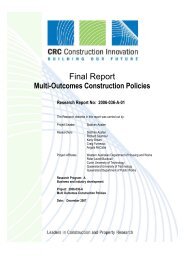A Practical Guide to Safety Leadership Book (PDF 5MB) - QUT ePrints
A Practical Guide to Safety Leadership Book (PDF 5MB) - QUT ePrints
A Practical Guide to Safety Leadership Book (PDF 5MB) - QUT ePrints
Create successful ePaper yourself
Turn your PDF publications into a flip-book with our unique Google optimized e-Paper software.
Step 1: Understand safety culture<br />
Industry examples<br />
The two case study excerpts provide an example of how Step 1: Understand safety culture can be implemented within a<br />
company. The complete case studies can be found in the Appendix at the end of the guide.<br />
Excerpt 1 (from case study 4 on page 31)<br />
Linking the A Construction <strong>Safety</strong> Competency Framework with developing safety culture in an organisation<br />
A Construction <strong>Safety</strong> Competency Framework provides <strong>to</strong>ols for companies <strong>to</strong> develop strategies <strong>to</strong> drive desirable<br />
behaviours and enable individuals <strong>to</strong> develop competencies. While they can be acquired using traditional training<br />
methods, they may be realised by establishing benchmarks.<br />
Baulders<strong>to</strong>ne Hornibrook recognises that the key <strong>to</strong> developing and sustaining a strong safety culture is the development<br />
and reinforcement of strong safety beliefs, values and positive attitudes across their organisation. It used the competency<br />
framework <strong>to</strong> focus on values and competencies, and <strong>to</strong> set benchmarks against its current competency statements.<br />
These were then refined so they aligned with existing safety culture development activities, enabling management <strong>to</strong><br />
better identify necessary development activities for new and existing staff as part of the cycle of personal development<br />
reviews. By using a combination of theoretical, philosophical and practical methods, Baulders<strong>to</strong>ne Hornibrook was<br />
able <strong>to</strong> manage and improve its safety culture.<br />
Excerpt 2 (from case study 5 on page 31)<br />
Linking competencies with current internal organisational documentation<br />
The St Hilliers Skills Matrix, developed by St Hilliers Contracting, is an internal competency and skills assessment<br />
framework that forms the foundation for the selection, training, development and performance management of staff.<br />
It was developed in response <strong>to</strong> management’s commitment <strong>to</strong> developing a safety culture, and its acknowledgment<br />
that it needed <strong>to</strong> manage its culture before developing training programs.<br />
The matrix comprises nine competency clusters, which include the technical and interpersonal skills required for all<br />
project-based staff. A Construction <strong>Safety</strong> Competency Framework was used <strong>to</strong> form the basis of the environment,<br />
systems and safety competency cluster in the matrix. It provides a <strong>to</strong>ol <strong>to</strong> measure the skills, knowledge and behaviours<br />
of construction project staff and will be incorporated in<strong>to</strong> all human resource and people management systems.<br />
Step 1: Understand safety culture 9

















